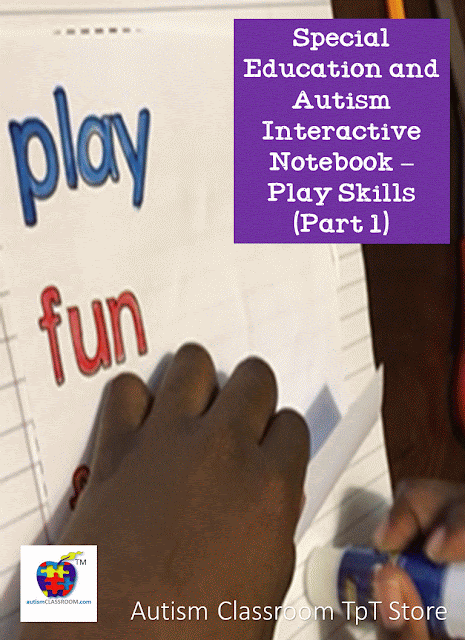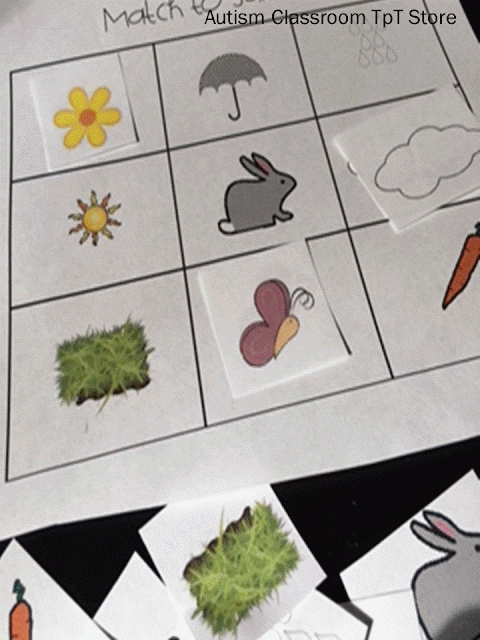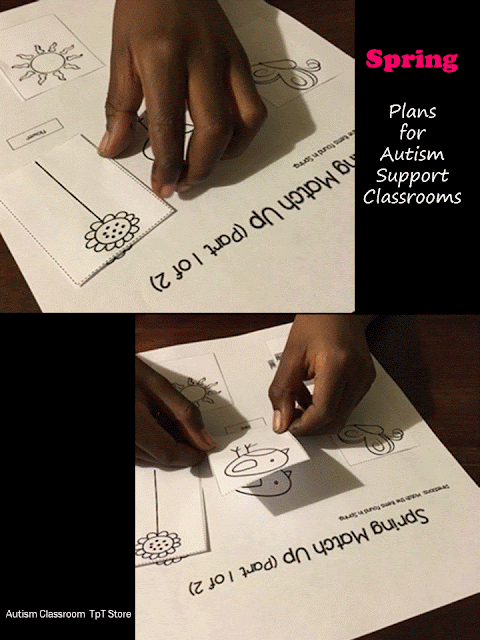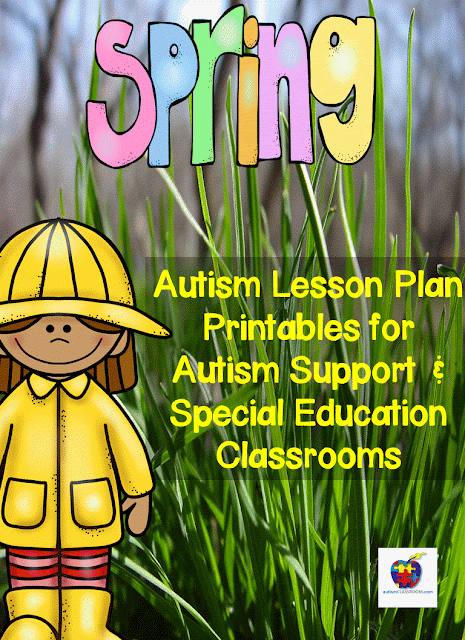 |
| Click here to see the Structured Play Board details. |

Mar 25, 2016
New Camera, New Possibilities
This new Nikon camera rocks!!!! I had it for a short while and did not really use it. Boy was I missing out. I gave it a try today and was able to capture some good photos of my Transportation Structured Play Communication Board. Take a look.
Labels:
classroom
,
teacher leader series
,
teachers
Mar 24, 2016
What to Teach When Teaching Play Skills to a Child with Autism (Play Series Part 3 of 3)
Play can be serious business. For young children, play is where they learn important concepts and new skills. For some children, this comes easily, and for others, it does not. Sometimes, we have to teach play skills...but where do we even start?
First, it might help to have the definition of the various types of play. For example, some types of play are:
Solitary Play- playing without seeming to notice others who may be close by.
Onlooker Play- watching others play, but not participating in the play.
Parallel Play- playing with the same toy or set of toys but not necessarily playing with other children who are nearby.
Cooperative Play- playing with a common goal or a shared activity.
Open-Ended Play- a play activity with various outcomes and no set limits on how to interact with the toy.
Close Ended Play- a play activity with one set outcome or a set expectation of how to play with the item.
Each of these skills can be fostered with a little support and guidance. Having a plan is essential for knowing what to teach. Some important elements of that plan are to include what vocabulary to teach, what visual supports to use and various ways to expand the play.
 |
| Play Skills Interactive Notebook (Click on the picture to learn more.) |
Additionally, consider these questions when teaching play:
What is this game that is being played?
What is this toy all about?
How does this toy work?
How does this activity go?
Is there a different way to play this game or is there only one way?
What visual supports can help the student understand and communicate during the play period?
The next consideration on what to teach might include teaching techniques that facilitate play. For one, some students may need help with establishing or adhering to boundaries. This may mean planning to use furniture, rugs, tables, and chairs to help establish boundaries. Some students have difficulty if they see a large open space. Sometimes by simply adding a chair and a table you can help them concentrate on the game or toy a little better. Also, just having a rug that serves as a visual reminder of where the toy play can take place could help some. For example, adults may remind the child, that toys stay in the rug area or that they should sit in this chair when playing this board game.
Another skill to teach during play is communication. One communication technique may be to include incidental teaching during play to increase communication. In incidental teaching a teaching scene might look like this:
After the child has approached an activity or object, or has attempted to get the object through a gesture or vocalization, approach the child. Your goal is to require him or her to elicit a more sophisticated response. Attempt to use a 3-level prompt hierarchy for this technique (Mirenda & Iacono I988):
1. Natural Prompt- “”What do you want?” or a questioning look.
2. Minimal Prompt- nonspecific verbal direction. “You need to tell me what you want, say, ‘want ____.”
3. Medium Prompt- request imitation. “You need to tell me what you want; say ‘want ____” and spontaneously sign or point to the communication symbol. The child must communicate to receive the item.
Other teaching techniques might include floor time, discrete trial teaching, pivotal response training, among others.
Having a support like the Play Skills Interactive Journal may provide guidance and a starting point. It provides ideas on what to teach. It includes ideas for each of these topics: Imitation, Play Skills, Cause and Effect, Cars and Trucks and Water Vehicles. It also includes visual supports that can aid with communication during play.
 |
| Visual Supports for each play theme. |
Happy Playing!
Labels:
autism
,
classroom
,
communication
,
lesson plans
,
lessons
,
play skills
,
products
,
social skills
,
teachers
Mar 20, 2016
Why Structure the Play for Students with Autism? (Play Series Part 2 of 3)
In the last post, the discussion focused on why we should teach play skills to students. However, it is important to remember to structure the play period for the child. What does structuring your play session accomplish?
For one, it helps establish some clarity for the student. Clarity makes it easy for them to see what the task is. Second, structuring the play session helps with the fact that some children have trouble with organizing. The adult can organize the play session, prepare the correct materials and serve as a guide for the student. Third, some students with autism have difficulty with sequencing events. Providing visual cues or reminders may help students needing to sequence during play. Using an interactive notebook before the play period to show the sequence of the play skill may help as well.
This Play Skills Interactive Notebook section focuses on teaching the sequence of steps for playing with cars.
The student glues in the number strip, then glues in the steps for playing with a car.
Another reason for structuring the play session for students with autism is to teach the rules and directions in a game. It is kind of hard to play a game if you do not know the rules. Within the structure of the play session, you can teach the rules of the activity or you can review the rules ahead of time, as is shown in the picture below.
Limited imitations skills are another reason to structure play. Students who can imitate are likely to be better at playing and interacting with others. They tend to be watching and learning by doing what others are doing. Some students have not gained this skill, but they can usually gain this skill when taught. It takes a structured, systematic approach to try to teach this skill. Additionally, as mentioned in the Why Teach Play Skills to Students with Autism post, building joint attention in students who do not currently have joint attention skills is important. Structuring your play can help teachers and parents to focus on this skill.
Have Fun!!!
Labels:
autism
,
classroom
,
lesson plans
,
play skills
,
products
,
tasks
,
teachers
Mar 19, 2016
Why Teach Play Skills to Students with Autism? (Part 1 of 3)
Autism, by definition includes difficulties with social skills, communication skills and sometimes behavior skills. Although not everyone with autism has difficulty in all of these areas, each of these areas affects the ability to play. Joint attention, which is the shared focus on an activity or an object is absent from many younger individuals with autism (until it is taught.) However, joint attention is needed to learn new skills, to share emotional states, to imitate actions and to learn. The hope is that if you increase joint attention, you will increase the other skills as well. One way to increase and teach joint attention in students could be through play.

I always wondered how I could target the play skills of students in a more structured and focused way. Then, I started to see the increase of teachers using interactive notebooks for topics like reading, science and math. It dawned on me that this might be a good the way to approach teaching play skills to students with autism. We already know that most lessons for our students require direct instruction, then practice. So why not for play? Enter.......the Play Skills Interactive Notebook!!!
This Play Skills Interactive Notebook (Part 1) is made up of activities that are meant to be worked on prior to the play period. They are meant to build the student's vocabulary and skills related to playing. After they topics are addressed in the notebook, then it is time to practice the skill in a real structured play situation. The topics covered in Part 1 are:
Imitation Skills
Play Skills
Cause and Effect
Cars and Trucks
Water Vehicles
Students can cut and paste the items into their notebooks. For example, one page has them sort pictures of children working and children playing.
Another activity has students coloring in letters to spell P-L-A-Y, then gluing them inside to make a mini flap book.
Cause and effect is addressed by having students make a flap up foldable. They choose an animal to open the flap for, and then, the student or the adult make the animal sound. This can be expanded by writing the name of the animal on the inside of the flap.
Matching is included as well. For this section of the interactive notebook, the students have to match 4 words related to playing.
While getting there, they work on pasting skills.
They also work on scissor skills during this activity.
 |
| Click for here to see the Play Skills Notebook |
Labels:
autism
,
characteristics
,
communication
,
cutting
,
lesson plans
,
parents
,
play skills
,
scissors
,
social skills
Mar 12, 2016
Language Based Activities and Printables for Spring
Who is ready for Spring themed lessons? I think it's time. These language based lessons have a spring theme. They cover a variety of spring topics including weather, Cinco de Mayo, graduation and others.


I decided to include many activities that have bunnies, butterflies and flowers among other fun spring things that kids like to talk about. In this one, the teacher reads the poem and the student has to cut out the pictures of the bunny and place the bunny high or low when the teacher asks. Teachers can emphasis "high" and "low" before, during and after the activity.

Don't forget the spring weather bonus file folder game!
Labels:
communication
,
file folder
,
lesson plans
,
teachers
Mar 7, 2016
Looking Forward to Spring with File Folders, Language Lessons and More
 |
| File Folder Game: Spring Matching |
Autism File Folder Games: Spring Matching
Next, there is my Spring Picture to Word Match (Match, Trace and Write)
This set includes 16 Spring related sight words and pictures. Each page has 2 cards. Laminate the page, cut the rectangular card and have students:
a. Say or point to the word.
b. Match the correct picture to the word.
c. Trace the word.
d. Write the word.
Also, there is a fun file folder with cute egg designs: Egg Hunt File Folder
Finally we cannot forget about Autism Lesson Plan Printables for Autism Support and Special Education Classrooms
These lessons include langauge support printables related to: Spring, April, Weather, May, Flowers, Cinco De Mayo, June, Graduation.
The cover has been updated for this resource. The old cover is below.
 |
| Former Cover for this Product |
Labels:
autismclassroom.com
,
classroom
,
lesson plans
,
morning work
,
products
,
teachers
Subscribe to:
Posts
(
Atom
)





































